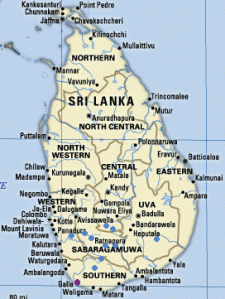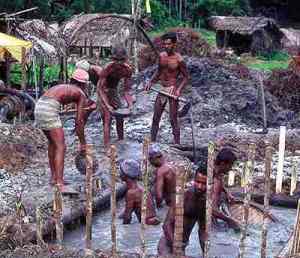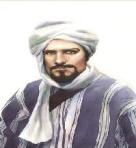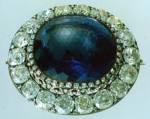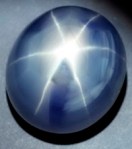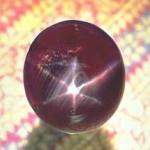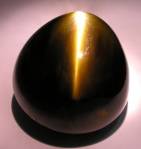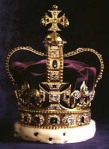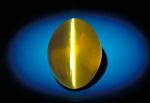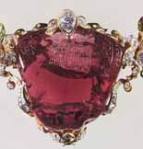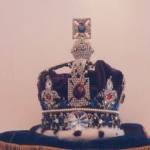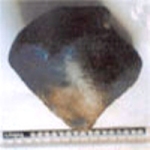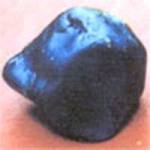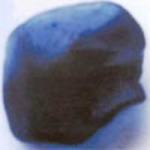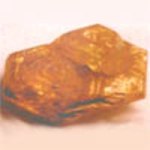The Muslims of Sri Lanka have been an intrinsic part of Sri Lankan community since the advent of Islam and the exploration of Arab, Indian, Persian and other Muslim traders to the Island. Sri Lanka has been known by many names, the island was called Serendib in Arabic which indicates seren (jewel) and dwip (island) showing the existence of the island has been known to Arabs since a long period of time. There have been Muslims in Sri Lanka for well over a thousand years. Historical records indicate the Arab trading presence in the island’s costal belt even before the origin of Islam. It was said the relationship in-between the Arab traders and the natives of the island were extremely cordial.
The Romans discovered the commercial value of Sri Lanka in the first century A.D. and the island was visited by Greeks, Romans, Persians, Arabs, and Chinese traders. Some of the trading commodities of Sri Lanka at that time were cinnamon, precious stones, pearls, elephants and ivory. The abatement of the Roman Empire in the 3rd century A.D had a periodic decline in the Roman trade and the Arabs and Persians filled up the vacuum; engaging in a rapidly flourishing inter-coastal trade. After the triumph of Persia, Syria and Egypt, the Arabs controlled all the important ports and trading stations between East and West. The Arabs from the Gulf had been coming straight to the island for trade and the significant migration for settlement came via the Malabar Coast in what is now Kerala. This brings to our mind the stories of the legendary Sinbad. The first Muslim merchants and sailors may have landed on Sri Lankan shores during the incipient era of Islam.
The first Mohammadians reached Ceylon were the members of the House of Hashim who fled in face of the persecution of the tyrannical Caliphs in the early part of the 8th century. The early Arab traders who visited Ceylon settled in the coastal belt of Ceylon concentrating mainly in the South Western towns of the country. However the traces of Arab links with Ceylon were evident well before the chronicles were penned. Sulaiman, an Arab trader and explorer, recounts his visit to Ceylon in 850 A.D. and mentioned a pilgrimage to Adam’s Peak. One cannot think of an Arabian, ignorant of the language of the indigenous inhabitants of a country, unlike its people in every respect in regard to habits, customs, diet and observances, undertaking a long and perilous journey into the heart of an unknown country. This surely suggests that the Arabs had been in the country for some time and they were known to the inhabitants of Ceylon and wielded influence and were therefore permitted to travel far into the interior in safety and comfort.
Fifty years later, in the year 900 A.D. it’s narrated of another Arab, named Abou Zaid, who supports the stories of Cosmas and Sulaiman and describes the still flourishing port of Kalah (Galle). Zaid’s narrations are based on the experiences of other travelers, one of whom was Ibn Wahab who included “Serendib” in his travels. Wahab like his predecessors made careful observations and collected much information regarding ancient Lanka for he is able to tell us that the Maya Rata or “Pepper Country”, one of the three oldest divisions of Ceylon, was situated between Kalah (Galle) on the coast and the Ruhuna Rata in the South East.
The Moors settlement in the coastal belt of Ceylon concentrated mainly in the South Western towns of the country and it’s noted the first Muslim settlement was in a port settlement in western Sri Lanka which was named Berbereen (Beruwala) in honor of the Berber traveler who founded the city. And the second settlement was in an area called Alutgamaweedia which was subsequently named Dharga town in the 1940's by the Muslims of that town. The grand mosque in Dharga town has archaeological evidence pointing to its historical origins.
The third settlement in the region was in Weligama a town further to the south of Berberyn. This city was known by its Arab name as as-Salawat. The biggest massacre of Muslims in the island by the Portuguese was committed here at Weligama where at least 10,000 Arab soldiers and their families were slaughtered mercilessly by the Portuguese who were renowned for their barbarity towards those who refused to convert to Christianity. The family names of the current Muslims in the region affirm the early ancestry.
Habituated to the local conditions in various ways the Muslims contributed extensively with their talents, wealth, and assisted to the development and progress of the country in a peaceful and comfortable manner, integrating with the society & blending with the local environment.
By about the tenth century the Arab trading societies were well established in Sri Lanka, especially in the island’s coastal towns enjoying the favor of the rulers and maintaining cordial relations with the local inhabitants. The Sinhalese in that era were not interested in trade and were appeased in agriculture and raising livestock. Trade was thus wide open to the Muslims. The Sinhalese Kings considered the Muslim settlements favorably on account of the revenue that they brought them through their contacts overseas both in trade and in politics. History accounts, Up to the Fourteenth Century, the Sinhalese were not familiar with mass-scale spinning and weaving of cloth. Of course, there were the ancient hand-loom and distaff, but the production was insufficient to meet the requirements of the entire population. Accordingly, they had to depend on India for their clothing. During this time the Sinhalese king delivered manifestos granting rewards to any individual who would go over to India and bring some skilled craftsman for the purpose of introducing the art of manufacture of cloth in Ceylon. About this time, a Moorman of Beruwella, motivated by the tempting offers made the voyage across Palk’s Strait and brought with him a batch of eight weavers of the Salagama caste, from a place call Saliapatanam.
As the story continues the eight persons referred to were drugged and secured on board and that they only realized that were being transported to a foreign country when they had been many miles out at sea. It is stated that two of the victims rather than being the subjects of such deception, jumped overboard and were never heard of again. The remaining weavers were granted a cordial welcome upon their arrival in Ceylon. In due course they were presented to the King who treated them with every kindness in order to induce them to commence practicing their craft locally. They were at the instance of the Court, married to women of distinction and given houses and lands. A manufactory was established for them in the vicinity of the Royal Palace.
The courtesy and avail of the moors attracted themselves into royal favor.This acquired them a higher authority which they used to bestow their ability to the fullest within their territory along the sea coast.
There is also a report in the history of Sri Lanka of a Muslim Ruler, Vathimi Raja, who reigned at Kurunegala (North Central Province) in the 14th century. This factor cannot be found in history books due to their omission, for reasons unknown, by modern authors. Vathimi Raja was the son of King Bhuvaneka Bahu I, by a Muslim spouse, the daughter of one of the chiefs. The Sinhalese son of King Bhuvaneka Bahu I, Parakrama Bahu III, the real heir to the throne was crowned at Dambadeniya under the name of Pandita Parakrama Bahu III. In order to be rid of his step brother, Vathimi Raja, he ordered that his eyes be gouged out. It is held that the author of the Mahavansa (ancient history of Ceylon) had suppressed the recording of this disgraceful incident. The British translator, Mudaliyar Wijesinghe states that original Ola (leaf script) was bodily removed from the writings and fiction inserted instead. The blinded Vathimi Raja (Bhuvaneka Bahu II or Al-Konar, abbreviated from Al-Langar-Konar, meaning Chief of Lanka of Alakeshwara) was seen by the Arab traveler Ibn Batuta during his visit to the island in 1344. His son named Parakrama Bahu II (Alakeshwara II) was also a Muslim. The lineage of Alakeshwara kings (of Muslim origin) ended in 1410. Although all the kings during this reign may not have been Muslims, the absence of the prefix -Shri Sangha Bodhi- (pertaining to the disciples of the Buddha) to the name of these kings on the rock inscriptions during this hundred year period may be considered as an indicator that they were not Buddhists. Further during Ibn Batutas visit a Muslim ruler called Jalasthi is reported to have been holding Colombo, maintaining his hold over the town with a garrison of about 500 Abyssinians.
Colonial Sri Lanka
The influx of Portuguese in 1505 afflicted the Muslims (Moors) in their status from which they never again recovered, as the Portuguese regarded them as their adversary in trade and enemies in faith. When the Portuguese first appeared on Sri Lankan shores, the Muslims warned the king, sangha, nobles and the people of the potential threat to the country's sovereignty.
The contest between these Portuguese and the Moors was an unequal one, as the Portuguese were trained and disciplined soldiers conversant with well equipped weapons & modern war methods unheard of by the peaceful and industrious Moor. History records while the Portuguese tried to gain a foothold in Colombo, the Muslims even provided firearms, fought side by side with the Sinhalese and even used their influence with South Indian powers to get military assistance to the Sinhalese rulers. The Portuguese expelled the Muslims from Colombo and forbade the worship of any other religion. Installing themselves in Colombo; the Portuguese commenced a vigorous campaign of the Cross. The Moors were subjected to every torture and humiliation.
The Moors made a huge effort to re-capture their fort, carrying on a powerful attack keeping the foreigners absent for a short time. Following a fearless fight on the part of the Moors they were forced to own defeat owning to the superiority of arms and power the Portuguese possessed. Motivated by this success and fearing a consequent attack, Portuguese proceeded to erect a factory and rebuild the old, mud fort of the Moors. The fort was entirely re-built with stone; both the Sinhalese and the Moors did everything that was possible to prevent the work being carried out but were brutally defeated.
Rajasinghe II, the king of Kandy desiring to get rid of the Portuguese who ruled most of the coastal area of the island made a treaty with the Dutch in 1638 who at that time had the largest merchant fleet in the world.. The main conditions of the treaty were that the Dutch should deliver the coastal areas they capture to the Kandyan king and the king should grant the Dutch a monopoly over trade on the whole island. The agreement was breached by both parties, however the consequence came out was only the substitution of one colonial power to another. By 1660 the Dutch controlled the whole island except the kingdom of Kandy and it was not until 1656 that Colombo fell.
It was during the Dutch period the Malays-who form a substantial element of the Muslim community, came to Ceylon. Almost all of the early Malay immigrants were soldiers, posted by the Dutch colonial administration to Sri Lanka, who decided to settle on the island. More immigrants added as the convicts or members of noble houses from Indonesia who were exiled to Sri Lanka and never left. When the Dutch capitulated to the British, the Malay soldiers joined the British troops and settled in Ceylon. Their separate identity has been preserved by the Malay language which includes numerous words absorbed from Sinhalese and the Moorish variant of the Tamil.
When the Dutch appeared and persecuted the Muslims in their coastal settlements, the Muslims ran to the Kandyan Kingdom. Senerat and Rajasimha II settled these Muslims in the Eastern coast. The Dutch who abolished the former as rulers of the sea-board were not prepared to give the Muslims even a small share of their commercial gains and therefore announced harsh regulations to keep them down. A regulation was passed prohibiting the residence of Moors within the vicinity of the towns of Galle, Matara and Weligama. This was at the time that Galle was the chief port of call for the island as well Matara and Weligama were also important trade centers. Difficulties which this law enforced on the trade of the Moors were excessively afflicting them. The Dutch tactfully ruined the business of their rivals wherever possible and during their 140-year rule, the Dutch, like the Portuguese, made repeated unsuccessful attempts to bring Kandy under their control.
The British ejected the Dutch in 1796, and in 1802 Sri Lanka became a crown colony. In 1815 the British won control of Kandy. The British did not follow the abhorring conversion policy carried out by the Portuguese towards the cross. Nor were the British as rough as the Dutch in their financial exploitations.
Around 1804, the alliance between the Sinhalese King and the maritime government was so confined that an outbreak of hostilities was expected. It was therefore considered unwise to regulate the payment of the head-tax and thereby antagonize the Moors who could be of service to the British in countless ways point out Lorna Dewaraja in her book. As in India the Muslims became a powerful weapon in the hands of the British; an ally who could be used to their advantage to undermine the power and influence of the king of Kandy. Governor Frederick North’s proclamation of 1799 preserving the laws applicable to the Muslims and the code of Mohammadian law effected in 1806, was an attempt to convince the Muslims of their separate identity. Even the abolition of the poll tax on Muslims imposed by the Dutch, which governor North described as “an oppressive and disgraceful tax on an industrious race” was motivated not by purely humanitarian considerations.
It’s also stated that Ceylon Moors were for the first time appointed to native ranks. One of the earliest of these was Hadjee of “Velassy” the distinguished, though little known Moor. A more popular individual was Uduman Lebbe Marikar Sheik Abdul Cader, the grandfather of the late I.L.M.Abdul Azeez, who in his day was a prominent member of the Moorish Community. “Sekady Marikar” by which name he was better known was appointed the head Moorman of Colombo by Sir Robert Brownigg, on June 10th, 1818. Several other appointments followed soon afterwards and the Moors were not only made chiefs in different parts of the Maritime Provinces, but also assigned in the public service.
As mentioned in the preceding part the Muslims in the coastal settlements ran to the Kandyan Kingdom as the Dutch tortured them in all channels. Senerat (1604-1635) and Rajasimha II (1635-1687) settled these Muslims. Lorna Dewaraja states it is also possible that the Muslims who were trading in the kingdom from the seventeenth century, at least were already associated with the madige at the time the fisher folk were affiliated to it. The Sinhala king in his capacity as head of the economic and social order had the power to assign economic functions and grant lands if he thought fit to any group of people extraneous or indigenous and incorporate them in to the badda system. In this process the fisher folks were absorbed into Sinhala society, but the Muslims were not thus acculturated because they clung tenaciously to their faith; but they functioned technically like a caste group. (Dewaraja. p 88)
In the reign of Keerthi Sri Rajasinha, Sheikh Alim, a Muslim was appointed madige badda (Transport department) nilame and after him his grandson, Sheikh Abdul Cader held the same office. Later, Makula Mohandiram, a Muslim was madige disave of the seven korales. Since the madige department included both Sinhalese and Muslims, here we find an example of Muslims rising to high offices of authority over the Sinhalese through their association with the badda system. Obviously, race and religion were no consequence when it came to appointments.
Although it is generally believed that the Muslims are versed only in the arts of trade and commerce it will be seen that there were other areas in which they excelled, one of which was medicine. Certain Sri Lankan Muslim families had distinguished physicians among their members, who rose to pre-eminence in the profession. In addition Muslims also functioned as weavers, tailors, barbers, and lapidarists.
A Muslim physician Suluttan Kuttiya, who was originally practicing medicine in Galle was invited to the Kandyan court, taken into royal service and given land near Gampola, where his descendants lived till 1874 and were known as Galle vederalala or the physician from Galle. Although one cannot be sure about the numbers, it is reasonable to assume that there was a drift of Muslims to the interior in the eighteenth century as well. They made the Kandyan kingdom their base and travelled up and down for purposes of trade when conditions were not unfavorable. The first generation of immigrants married Kandyan women and their offspring who were invariably socialized as Muslims, either intermarried among themselves or married new immigrants of the same faith so that with each generation the Islamic identity was maintained and strengthened. (Dewaraja. p 97,p123).
Muslims as Functionaries in the Dalada Maligava or the temple of the tooth
The Muslims were involved in the functioning of the Dalada Maligava. The Service Tenure Register of the Kandy district prepared in 1872 gives the names of several Muslims who were occupying service shares belonging to the maligava in return for service.
The Dalada Maligava owned extensive lands called maligagam and the administration of these was entirely in the hands of a lay officer called the diyavadana nilame, appointed by the king from the radala aristocracy. So in a largely non-monetary economy the services rendered to the maligava were paid by grants of land. The supply of salt and dried fish could be considered as a purely utilitarian service rendered by the Muslims and involved no religious or cultural significance. Two Muslims, Mohammed Lebbe and Udum Lebbe occupied the lunudena panguva ( the share that supplies salt) of the village of Pallegampaha Kahavatta belonging to the Dalada Maligava. The service attached to the share was to supply the maligava with 20 measures of “good clean salt” for the New Year festival. It is clear from the foregoing that Muslims were involved in the administrative and ritual aspects of the functioning of the dalada maligava. (Dewaraja. p 103-p107).
The tradition connected with the Kahatapitiya mosque near Gampola further illustrates the munificence of the Sinhala kings towards the Muslims. The site where the mosque now stands was a waste land with few trees. According to tradition an ascetic from Mecca sat here in mediation and his dignified motionless posture struck the attention of a toddy tapper who had come to tap the palm tree. In order to ascertain whether this figure was alive or dead, the tapper is said to have sliced off the tip of his nose. The ascetic remained motionless. The following morning the toddy tapper was astonished to see the piece he had cut off re-attached to the nose. The tapper was overawed and related his experience to the Gampola king, who visited the ascetic and asked him what he needed ‘’only a strip of land to lay my head on,” was the reply. When the king wished to know the extent required, the ascetic threw his bangle called the sakkara valalla in four directions and indicated the area. This was granted and the area is still known as sakkarankotuva. The saint Bhavakauf was deified and a tomb was built in his memory. Later a mosque sprang up on the same place and it continues to be a well known place of pilgrimage. Also many lands have been granted to moor men representing high authority within the kingdom, the Lindekotuwa Gedara granted to Abdul Quddus in Gampola and several other offerings made to dignitaries shows how the kandyan king showed remarkable contributions and tolerance towards the Muslims.
There are several Muslims families in the Udarata even today bearing the family names Mohandiramlage, Vidanelage and Lekamage all of which signify their official connections in the past. And as we examine this long odyssey of Ceylon moors, it reveals a kind of saga where the foundation of an old community had
been laid by early Arab traders.
- Zeyan Hashim

